Cos, isle of Cos, Greece, Sunday evening, 10 June 2001
Friday morning I continued my efforts to obtain the US dollars we need to enter Turkey, and I finally succeeded, but I had to drive all the way back to Rhodes for the purpose. (We were going back there the next day too for our boat to Cos, but I didn't like my chances so well on a Saturday.)
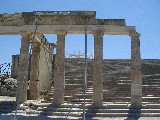
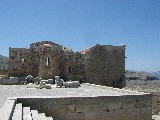 When I got back we lunched at the villa and then proceeded up to the acropolis. It is deep in the throes of reconstruction, particularly the classical temple of Athena (of which only the scaffolding shows at left, peeping over the top stair). Even the Hellenistic stoa at the foot of the grand staircase to the propylaea has lately been rebuilt in all new materials, as the few original column drums used in the earlier reconstruction had deteriorated. At right, a ruined Byzantine church shares the space with classical remains.
When I got back we lunched at the villa and then proceeded up to the acropolis. It is deep in the throes of reconstruction, particularly the classical temple of Athena (of which only the scaffolding shows at left, peeping over the top stair). Even the Hellenistic stoa at the foot of the grand staircase to the propylaea has lately been rebuilt in all new materials, as the few original column drums used in the earlier reconstruction had deteriorated. At right, a ruined Byzantine church shares the space with classical remains.
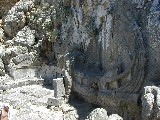
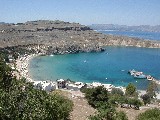 At left, the way up to the medieval-walled citadel features this Hellenistic semicircular exedra (speaking podium) and a relief carving of a ship. At right, the view down from the acropolis to the beach and bay, whither the children and I repaired after our hot climb.
At left, the way up to the medieval-walled citadel features this Hellenistic semicircular exedra (speaking podium) and a relief carving of a ship. At right, the view down from the acropolis to the beach and bay, whither the children and I repaired after our hot climb.
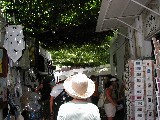 By the time we left Lindos yesterday morning we were pretty well sick of the place (at least the grownups, that is). It is about the most touristy place one could imagine--even Rhodes itself pales by comparison, and it is no slouch in that respect. With both, but especially with Lindos, the complete saturation with tourist shops and tavernas makes the medieval maze of narrow streets at once much easier and a lot less fun to get thoroughly lost in, because the shops are all so much alike.
By the time we left Lindos yesterday morning we were pretty well sick of the place (at least the grownups, that is). It is about the most touristy place one could imagine--even Rhodes itself pales by comparison, and it is no slouch in that respect. With both, but especially with Lindos, the complete saturation with tourist shops and tavernas makes the medieval maze of narrow streets at once much easier and a lot less fun to get thoroughly lost in, because the shops are all so much alike.
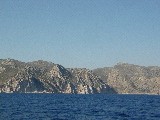

 Here are a few views of passing islandscape, taken from the afterdeck of the hydrofoil we took from Rhodes to Cos yesterday afternoon. It was twice as fast and costly as the regular boat, but hot and stuffy inside (which was one reason I favored the afterdeck) and with less to do besides sit in ranks in the saloon.
Here are a few views of passing islandscape, taken from the afterdeck of the hydrofoil we took from Rhodes to Cos yesterday afternoon. It was twice as fast and costly as the regular boat, but hot and stuffy inside (which was one reason I favored the afterdeck) and with less to do besides sit in ranks in the saloon.
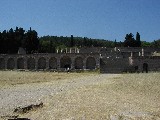
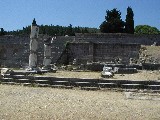
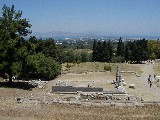 This morning we visited the Asclepieion outside the town. Though nothing here dates from so early as the time of Hippocrates, the island and city's favorite son, his legacy of rational medicine presumably shaped the healing practices here. At left is a view of the lowest of the three terraces into which the site is divided, with the upper terraces in the background. At right is the temple of Asclepius on the middle terrace, dating from the third century B.C. and the oldest foundation on the site.
This morning we visited the Asclepieion outside the town. Though nothing here dates from so early as the time of Hippocrates, the island and city's favorite son, his legacy of rational medicine presumably shaped the healing practices here. At left is a view of the lowest of the three terraces into which the site is divided, with the upper terraces in the background. At right is the temple of Asclepius on the middle terrace, dating from the third century B.C. and the oldest foundation on the site.
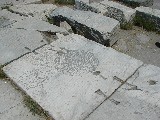
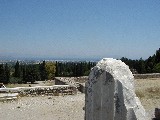
 The topmost terrace was occupied by a Doric peripteral temple, also dedicated to Asclepius of course. The detail of marble foundation far left shows with exceptional clarity not only where the columns of an inner colonnade were based, but also the mortising for lead-sheathed iron connectors between the blocks. To the north the temple commands a view across the sea to the Turkish coast, and now as formerly it is surrounded on the other sides by forest.
The topmost terrace was occupied by a Doric peripteral temple, also dedicated to Asclepius of course. The detail of marble foundation far left shows with exceptional clarity not only where the columns of an inner colonnade were based, but also the mortising for lead-sheathed iron connectors between the blocks. To the north the temple commands a view across the sea to the Turkish coast, and now as formerly it is surrounded on the other sides by forest.

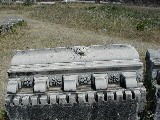 Back down on the middle terrace one can see (left) the vestiges of the central altar of the god and a Roman-era temple, and (right) a fallen block of the entablature from that temple.
Back down on the middle terrace one can see (left) the vestiges of the central altar of the god and a Roman-era temple, and (right) a fallen block of the entablature from that temple.

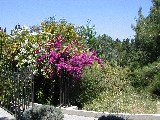 Abundant floral plantings around the approach made the site more pleasant.
Abundant floral plantings around the approach made the site more pleasant.
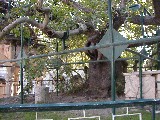
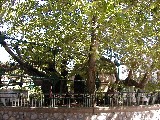 In the town of Cos itself, one of the landmarks is this ancient and yet-living plane tree, fenced around, with its split and hollowed trunk carefully coated on the inside, and its branches cradled in an iron framework. Tradition holds that Hippocrates taught under its shade.
In the town of Cos itself, one of the landmarks is this ancient and yet-living plane tree, fenced around, with its split and hollowed trunk carefully coated on the inside, and its branches cradled in an iron framework. Tradition holds that Hippocrates taught under its shade.

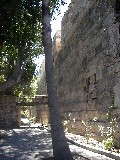
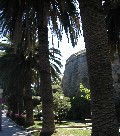 After swimming at the beach for a while with the rest of the family, Larissa and I set out for a little further exploration of the town. The harbor is dominated by a castle, built here by the same order of crusaders who built so much of old Rhodes (and wound up as the Knights of Malta). Not being able to gain admission at that hour, we circled round it.
After swimming at the beach for a while with the rest of the family, Larissa and I set out for a little further exploration of the town. The harbor is dominated by a castle, built here by the same order of crusaders who built so much of old Rhodes (and wound up as the Knights of Malta). Not being able to gain admission at that hour, we circled round it.
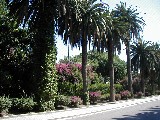 Palm trees are particularly prevalent here.
Palm trees are particularly prevalent here.
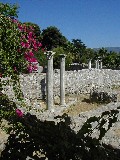
 Larissa and I then toured the agora. I was particularly struck by this reconstructive attempt to show two buildings of two different eras--a late classical stoa, with beautifully grained monolithic column shafts, and an early medieval basilica.
Larissa and I then toured the agora. I was particularly struck by this reconstructive attempt to show two buildings of two different eras--a late classical stoa, with beautifully grained monolithic column shafts, and an early medieval basilica.

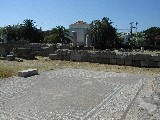
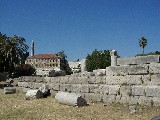 At left, an avenue and a mosaic floor; at right, a sanctuary of Aphrodite.
At left, an avenue and a mosaic floor; at right, a sanctuary of Aphrodite.
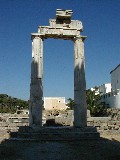
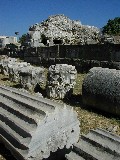
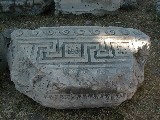 The two standing Doric columns at left seem to have belonged to a courtyard that may have served as entrance to the agora. Looking at the general line of foundation blocks, I at first assumed that this would be a back view of the colonnade, from inside some kind of building; but the entablature (with lion-head drain-spout) and the stepped foundation both show the contrary, suggesting that the vantage for this photo would have been in a courtyard defined by some L- or even U-shaped stoa. At right, some choice bits and pieces from among those scattered around the site, and presumably missed by the crusaders when they plundered the place for building stones.
The two standing Doric columns at left seem to have belonged to a courtyard that may have served as entrance to the agora. Looking at the general line of foundation blocks, I at first assumed that this would be a back view of the colonnade, from inside some kind of building; but the entablature (with lion-head drain-spout) and the stepped foundation both show the contrary, suggesting that the vantage for this photo would have been in a courtyard defined by some L- or even U-shaped stoa. At right, some choice bits and pieces from among those scattered around the site, and presumably missed by the crusaders when they plundered the place for building stones.
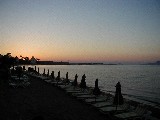
 Our last full day on Greek soil ended with sunset over the castle and the Turkish coast opposite. It was a sad occasion in a way, but Turkey's Aegean coast was also part of ancient Greece, and even today has a lot in common with modern Greece (apart from the big two, language and religion), so perhaps the break will not feel complete right away.
Our last full day on Greek soil ended with sunset over the castle and the Turkish coast opposite. It was a sad occasion in a way, but Turkey's Aegean coast was also part of ancient Greece, and even today has a lot in common with modern Greece (apart from the big two, language and religion), so perhaps the break will not feel complete right away.
previous entry
main/ToC page

 When I got back we lunched at the villa and then proceeded up to the acropolis. It is deep in the throes of reconstruction, particularly the classical temple of Athena (of which only the scaffolding shows at left, peeping over the top stair). Even the Hellenistic stoa at the foot of the grand staircase to the propylaea has lately been rebuilt in all new materials, as the few original column drums used in the earlier reconstruction had deteriorated. At right, a ruined Byzantine church shares the space with classical remains.
When I got back we lunched at the villa and then proceeded up to the acropolis. It is deep in the throes of reconstruction, particularly the classical temple of Athena (of which only the scaffolding shows at left, peeping over the top stair). Even the Hellenistic stoa at the foot of the grand staircase to the propylaea has lately been rebuilt in all new materials, as the few original column drums used in the earlier reconstruction had deteriorated. At right, a ruined Byzantine church shares the space with classical remains.































